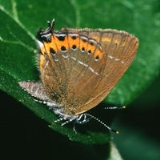
Black Hairstreak
Encyclopedia
The Black Hairstreak is a butterfly
in the family Lycaenidae
.
but the Black Hairstreak has a row of orange spots along the edge of the upper-side hindwing. In the female these spots also extend to the forewings. The undersides are similar to the White-letter but the white line tends to be straighter and the orange border extends onto the forewings. The most conclusive way to distinguish the two is by the row of black spots accompanying the orange band which the White-letter Hairstreak never has. They spend most of their lives in the canopy or in dense scrub, feeding on honeydew
, and very rarely come down to ground level. In the UK there are now only about 45 colonies, all in a small part of the East Midlands between Oxford and Peterborough. Historically there have been around 90 known colonies since its discovery in 1828 but there have been many, mostly unsuccessful, introductions at various locations in southern England including one in Surrey in 1952 that seemed to be successful until the habitat was destroyed. It is widespread across Europe and Asia as far as Japan.
Prunus spinosa growth and it is this stage which hibernates. Although Blackthorn is the main foodplant, Wild Plum
Prunus domestica and other Prunus spp are occasionally used. The caterpillar hatches the following spring, at the end of April, just before the buds open and feeds on the flower buds. Older larvae are green and well camouflaged against the leaves on which they feed. Pupation takes place on leaves or twigs in June and the pupae are patterned black and white to mimic a bird dropping, as a defence against being eaten. The adult butterflies of this single-brood (univoltic) species are on the wing from the end of June to mid July.
Butterfly
A butterfly is a mainly day-flying insect of the order Lepidoptera, which includes the butterflies and moths. Like other holometabolous insects, the butterfly's life cycle consists of four parts: egg, larva, pupa and adult. Most species are diurnal. Butterflies have large, often brightly coloured...
in the family Lycaenidae
Lycaenidae
The Lycaenidae are the second-largest family of butterflies, with about 6000 species worldwide, whose members are also called gossamer-winged butterflies...
.
Appearance, behaviour and distribution
This small brown butterfly is one of Britain's most localised and rarest. At first glance it is very similar to the White-letter HairstreakWhite-letter Hairstreak
The White-letter Hairstreak is a butterfly in the family Lycaenidae.-Appearance, behaviour and distribution:A dark little butterfly that spends the majority of its life in the tree tops, feeding on honeydew, making it best observed through binoculars. The uppersides are a dark brown with a small...
but the Black Hairstreak has a row of orange spots along the edge of the upper-side hindwing. In the female these spots also extend to the forewings. The undersides are similar to the White-letter but the white line tends to be straighter and the orange border extends onto the forewings. The most conclusive way to distinguish the two is by the row of black spots accompanying the orange band which the White-letter Hairstreak never has. They spend most of their lives in the canopy or in dense scrub, feeding on honeydew
Honeydew (secretion)
Honeydew is a sugar-rich sticky liquid, secreted by aphids and some scale insects as they feed on plant sap. When their mouthpart penetrates the phloem, the sugary, high-pressure liquid is forced out of the gut's terminal opening. Honeydew is particularly common as a secretion in the Hemipteran...
, and very rarely come down to ground level. In the UK there are now only about 45 colonies, all in a small part of the East Midlands between Oxford and Peterborough. Historically there have been around 90 known colonies since its discovery in 1828 but there have been many, mostly unsuccessful, introductions at various locations in southern England including one in Surrey in 1952 that seemed to be successful until the habitat was destroyed. It is widespread across Europe and Asia as far as Japan.
Life cycle and foodplants
Eggs are laid singly on young BlackthornBlackthorn
Prunus spinosa is a species of Prunus native to Europe, western Asia, and locally in northwest Africa. It is also locally naturalised in New Zealand and eastern North America....
Prunus spinosa growth and it is this stage which hibernates. Although Blackthorn is the main foodplant, Wild Plum
Plum
A plum or gage is a stone fruit tree in the genus Prunus, subgenus Prunus. The subgenus is distinguished from other subgenera in the shoots having a terminal bud and solitary side buds , the flowers in groups of one to five together on short stems, and the fruit having a groove running down one...
Prunus domestica and other Prunus spp are occasionally used. The caterpillar hatches the following spring, at the end of April, just before the buds open and feeds on the flower buds. Older larvae are green and well camouflaged against the leaves on which they feed. Pupation takes place on leaves or twigs in June and the pupae are patterned black and white to mimic a bird dropping, as a defence against being eaten. The adult butterflies of this single-brood (univoltic) species are on the wing from the end of June to mid July.

